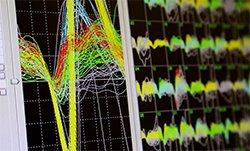
The research -- led by Duke University neuroscientist Miguel Nicolelis, M.D., Ph.D., as part of the Walk Again Project in São Paolo, Brazil -- offers promise for people with spinal cord injury, stroke and other conditions to regain strength, mobility and independence.
“We couldn’t have predicted this surprising clinical outcome when we began the project,” said Nicolelis, co-director of the Duke Center for Neuroengineering who is originally from Brazil.
“What we’re showing in this paper is that patients who used a brain-machine interface for a long period of time experienced improvements in motor behavior, tactile sensations and visceral functions below the level of the spinal cord injury,” he said. “Until now, nobody has seen recovery of these functions in a patient so many years after being diagnosed with complete paralysis.”
Several patients saw changes after seven months of training. After a year, four patients’ sensation and muscle control changed significantly enough that doctors upgraded their diagnoses from complete to partial paralysis.